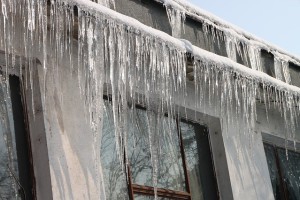Houses, apartment complexes, and businesses all around New England are covered with beautiful icicles this time of year. They are fierce looking statement to the ferocity of the winter of 2015! Though pretty, icicles are often a sign of ice buildup around your gutters. This build up can lead to ice dams where water is trapped behind snow and ice and can’t access the gutters. The water eventually works its way into the roof and will often cause damage to inner walls and ceilings.
Analyzing The Problem

Icicles, though beautiful, are telltale signs of an ice dam.
Standing near your road and looking at your roof can be a very telling thing. It’s likely you will see the roof over the main part of your house showing signs of melting while the eves are still frozen solid. It’s a little bit like an infrared camera. The amount of snow tells you where heat is being released and how much heat is being released. Of course warm temperatures or an extended period of sunshine will greatly affect the amount of snow. Even in New England, many houses lose a tremendous amount of heat in the winter. If you are the process of building a new house or are doing some serious remodeling, such as installing a new roof, take the time to make sure you are getting the building sealed correctly. This will save you many headaches down the road.
Rake Or Knock The Snow Off Your Roof
One solution to the problem is to get your hands on an extendable roof rake and clean the snow off your roof. This is also a great idea if you are getting abnormally high amounts of snow fall as that can put unwanted pressure on the structure of you roof.
The Panty Hose Solution
A little bit of a fun solution. Fill the leg of an unwanted pair of panty hose with a calcium chloride ice melt solution. Throw the hose onto the roof so it lays across the ice dam and slightly overhangs your gutter. You may have to use a long-handled yard tool like a rake or hoe to push it into position. The calcium chloride will eventually melt through the snow and ice and to create a channel allowing the water to run down to your gutters or off the roof.
Blowing Cold Air On The Roof
The best way to avoid an ice dam and potential leaking is to regulate the temperature of the roof. As long as the roof is cold, it will remain iced and the water will not find a way into your house. Just take a circular fan or two up to your attic and position them on the areas of the roof that are experiencing ice dams, it will freeze quickly. Experts say this solution usually stops the leaking in a matter of an hour or so.
Seal Major Leaks
An unsealed attic access hatch or whole-house fan is a great way to release large amounts of heat into your attic. To insulate an attic hatch, you will have to remove the trim. If the gaps are small, preferably less than 1/4″ use caulking to fill the gap. For gaps larger than 1/4” use a foam sealant. These insulators will seal the gap between the hatch framing and the rough cut drywall. Then attach several layers of foam board to the cover until you have at least six inches of foam. Building a similar foam block is a great way to insulate a whole house fan. This will greatly reduce the effect of these heat leaks.
Protecting your property from water damage is important. Water can affect your interior walls, but it can also damage less visible areas like your attic. In New England, you have to fight winter smarter, because half of the battle is prevention. If you would like to schedule an expert consultation or if you have questions about ice control, snow removal, or other winter needs, please contact us at Greener Horizon in Middleboro, MA.






